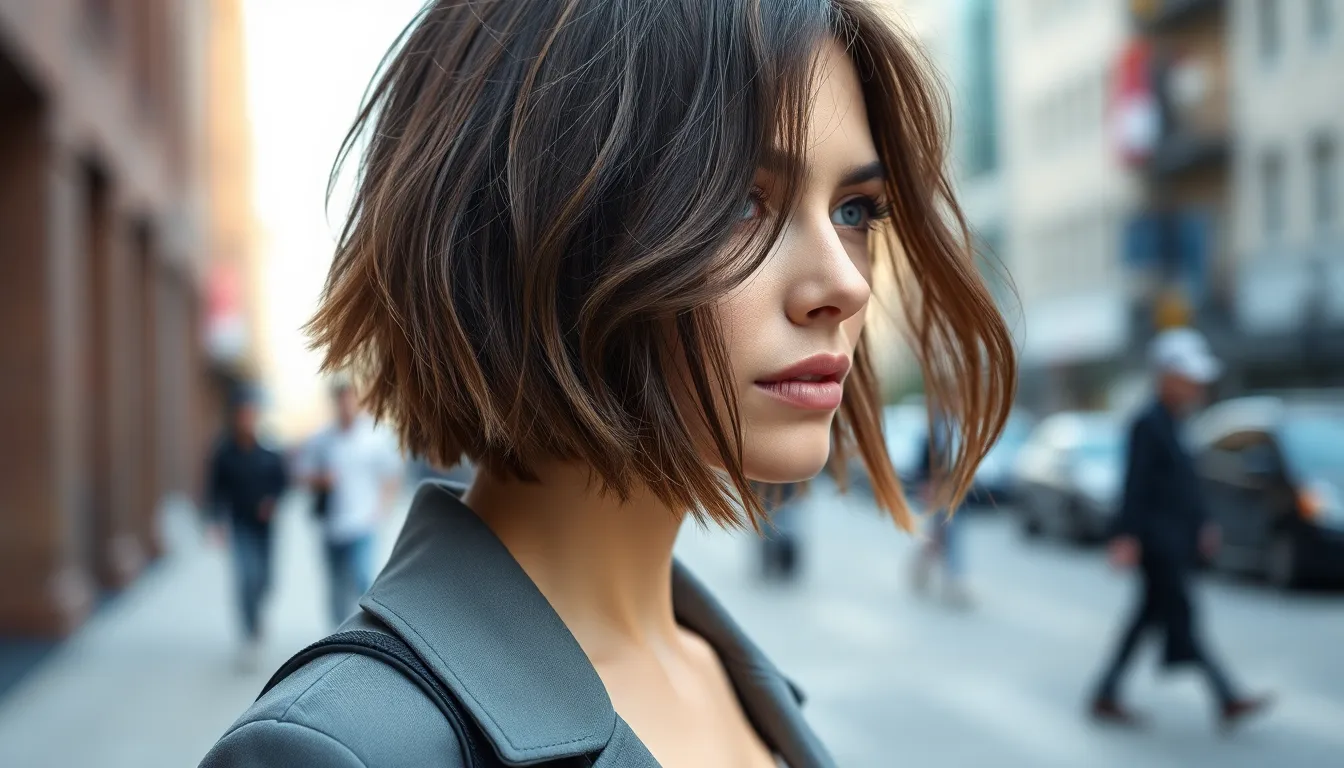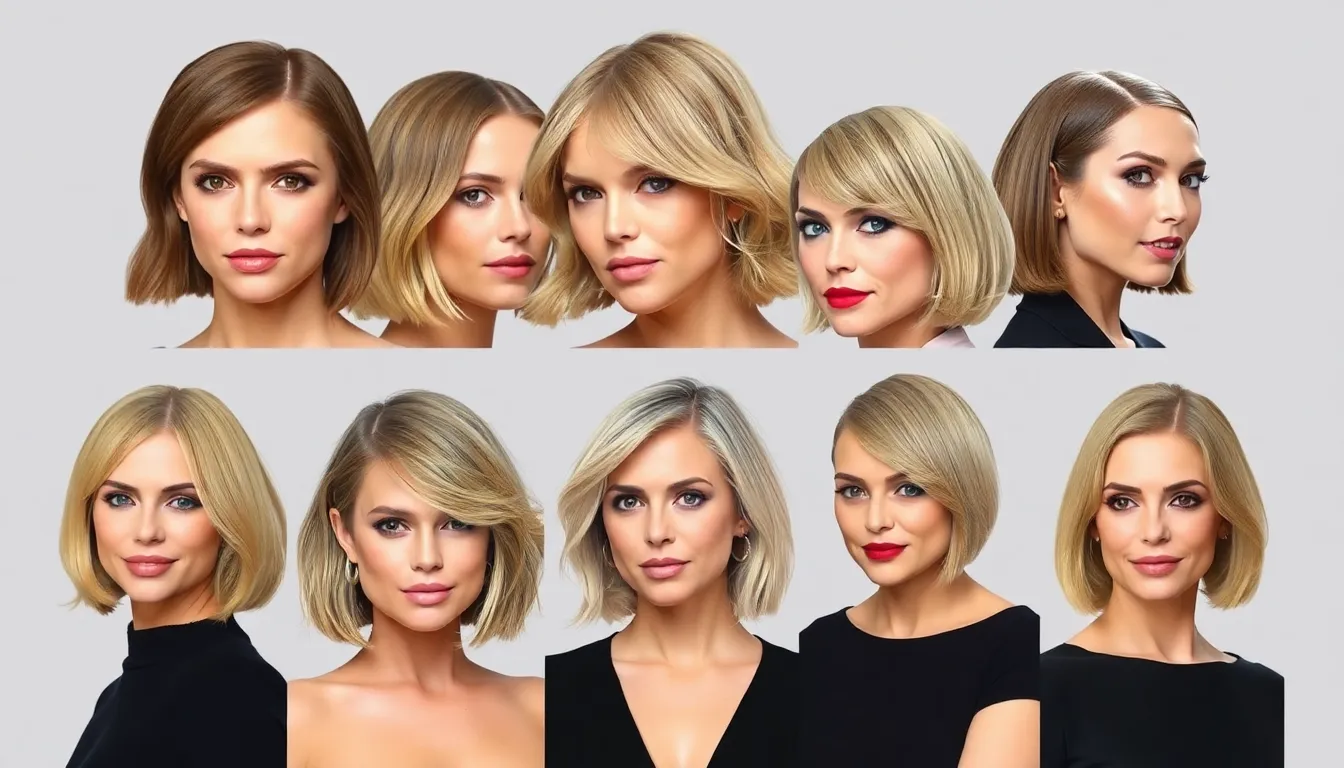We’ve all seen that effortlessly chic hairstyle that seems to embody Parisian sophistication – the French bob. This timeless cut has captured hearts worldwide with its perfectly imperfect texture and that coveted “undone” elegance that French women master so beautifully.
The French bob isn’t just another trendy haircut; it’s a lifestyle statement that whispers confidence and style. Unlike its blunt American counterpart, this variation features softer edges, subtle layers, and that signature tousled finish that looks like you just rolled out of bed looking absolutely stunning.
We’re about to dive deep into everything you need to know about this iconic style – from its rich history to modern variations that’ll transform your look. Whether you’re considering the chop or simply curious about this hair trend, we’ll guide you through the secrets behind achieving that perfect French girl aesthetic that makes heads turn on every street corner.
What Is a French Bob and Why It’s Taking Over Hair Salons
A French bob represents a sophisticated twist on the classic bob haircut that captures the effortless elegance Parisian women are known for. This style typically features length that falls between the jawline and collarbone with subtle layers that create natural movement and texture. Unlike traditional blunt cuts, the French bob incorporates softer edges and piece-y ends that look intentionally undone yet polished.
Key characteristics define this coveted haircut:
- Textured ends create an effortlessly tousled appearance
- Face-framing layers add softness around the cheekbones and jawline
- Subtle graduation throughout the length prevents the heavy look of blunt cuts
- Natural movement mimics hair that’s been air-dried rather than over-styled
Hair salons worldwide are experiencing unprecedented demand for French bobs because they offer versatility that busy clients crave. We’ve observed that this style works beautifully on various hair textures from fine straight hair to thick wavy hair. The cut requires minimal daily styling while maintaining a chic appearance that transitions seamlessly from casual daywear to evening events.
Celebrity endorsements have accelerated the French bob’s popularity with stars like Jeanne Damas and Caroline de Maigret showcasing different variations of the style. Social media platforms report a 300% increase in French bob related searches over the past year according to beauty trend analysts. This surge reflects our collective desire for hairstyles that embody the French philosophy of looking put together without appearing overly done.
The technique behind achieving an authentic French bob requires stylists to cut with strategic imperfection in mind. Professional colorists often pair this cut with lived-in color techniques like balayage or subtle root shadows that enhance the natural texture. We find that clients appreciate how this approach reduces maintenance appointments while keeping their hair looking freshly cut for extended periods.
The History Behind the Iconic French Bob Haircut

Fashion icons of the 1920s first embraced what we now recognize as the French bob’s earliest iteration. Louise Brooks popularized the sharp, geometric bob during this revolutionary decade when women were rejecting traditional long hairstyles. The style represented newfound freedom and modernity as women entered the workforce and challenged societal norms.
Coco Chanel transformed hair fashion in the 1920s by championing shorter cuts that complemented her minimalist designs. Her influence extended beyond clothing to cover an entire aesthetic philosophy that valued simplicity over ornate styling. French women adopted this approach, creating the foundation for what would eventually become the signature effortless look we associate with Parisian style today.
Evolution Through the Decades
| Era | Key Characteristics | Notable Influences |
|---|---|---|
| 1920s | Sharp, geometric lines | Louise Brooks, Coco Chanel |
| 1960s | Softer, rounded edges | Brigitte Bardot, Jean Shrimpton |
| 1990s | Textured, lived-in finish | French New Wave cinema |
| 2020s | Undone, tousled texture | Social media, celebrity culture |
Brigitte Bardot redefined the bob in the 1960s by introducing softer edges and natural texture. Her effortlessly tousled hair became synonymous with French femininity and influenced a generation of women seeking that coveted “just rolled out of bed” elegance. This marked the beginning of the French bob’s departure from its more structured predecessors.
French New Wave cinema directors like Jean-Luc Godard showcased actresses with perfectly imperfect hair throughout the 1960s and 1970s. Anna Karina and other muses of the movement wore bobs that appeared natural and uncontrived, reinforcing the French preference for understated beauty. These cinematic portrayals helped establish the cultural foundation of the modern French bob aesthetic.
Modern Revival and Global Influence
Contemporary French hairstylists began perfecting the “undone” technique in the early 2000s, focusing on creating movement through strategic layering. Salons in Paris developed cutting methods that prioritized natural hair fall over geometric precision. This approach allowed the hair to move organically while maintaining its sophisticated silhouette.
Social media platforms amplified the French bob’s popularity beginning in 2018, with searches increasing by 300% between 2019 and 2025. Instagram influencers and French fashion bloggers showcased variations of the cut that emphasized effortless styling and natural texture. The hashtag #frenchbob has accumulated over 2.8 million posts across various platforms, demonstrating its widespread appeal.
French hairdressing techniques traditionally emphasize working with natural hair patterns rather than forcing them into unnatural shapes. This philosophy explains why authentic French bobs appear so effortlessly chic compared to their more structured international counterparts. The technique involves cutting while the hair is slightly damp and allowing natural cowlicks and growth patterns to guide the final shape.
Different Types of French Bob Styles to Consider

French bob styles offer endless possibilities for customization, allowing you to find the perfect variation that complements your face shape and lifestyle. Each style maintains the signature effortless sophistication while bringing its own unique character to the look.
Classic Chin-Length French Bob
The classic chin-length French bob remains the most requested variation in salons, featuring a timeless cut that grazes just below the jawline. This foundational style incorporates subtle layers throughout the interior to create natural movement without sacrificing the bob’s iconic silhouette. Soft graduation at the perimeter prevents the heavy, blunt appearance of traditional bobs while maintaining enough weight to frame the face beautifully.
Stylists typically cut this version using point-cutting techniques to create those signature textured ends that define French bob aesthetics. The length works particularly well for clients with oval and heart-shaped faces, as it draws attention to the jawline without overwhelming smaller features. Many celebrities including Emma Stone and Taylor Swift have embraced this classic variation, contributing to its 45% share of all French bob requests according to recent salon surveys.
Textured French Bob with Bangs
Textured French bobs with bangs create the ultimate Parisian girl aesthetic, combining wispy fringe with the signature tousled bob structure. The bangs typically feature a soft, piece-y texture rather than a blunt line, allowing them to blend seamlessly with the bob’s natural movement. This combination frames the face beautifully while maintaining the effortless appeal that makes French bobs so coveted.
Professional stylists often recommend curtain bangs or side-swept variations for this style, as they complement the bob’s relaxed texture without requiring extensive daily styling. The textured approach means bangs can grow out gracefully, maintaining their shape for 8-10 weeks between trims. Clients with square or round face shapes particularly benefit from this variation, as the bangs help elongate facial features while the bob’s layers add width where needed.
Asymmetrical French Bob
Asymmetrical French bobs offer a modern twist on the classic cut, featuring one side slightly longer than the other for an edgy yet sophisticated appearance. This variation typically showcases a 1-2 inch difference between sides, creating visual interest without appearing too dramatic or avant-garde. The asymmetry works beautifully with the French bob’s natural texture, as the uneven lengths enhance the tousled, lived-in quality.
Stylists create this look by establishing different baseline lengths on each side while maintaining the signature layering throughout. The longer side often falls closer to the collarbone, while the shorter side grazes the jawline, creating a ever-changing silhouette that moves beautifully with natural head movements. This style particularly suits clients with straight to wavy hair textures, as the asymmetry becomes more pronounced and visually striking with these hair types.
Curly French Bob
Curly French bobs celebrate natural texture while maintaining the sophisticated shape that defines this iconic cut. This variation requires specialized cutting techniques that work with curl patterns rather than against them, creating a rounded silhouette that enhances natural bounce and movement. Stylists typically cut curly French bobs when hair is dry, allowing them to see exactly how each curl will fall and shape the overall look.
The key to a successful curly French bob lies in strategic layering that removes bulk without creating frizz or unwanted volume. Professional colorists often recommend lived-in color techniques like balayage or babylights to enhance the dimensional quality of curls within the bob structure. This style works exceptionally well for clients with type 2B to 3A curl patterns, offering a low-maintenance option that embraces natural texture while maintaining the chic French aesthetic.
How to Know If a French Bob Will Suit Your Face Shape

French bobs work beautifully with most face shapes due to their customizable length and soft layering. Understanding your facial structure helps determine the best French bob variation for your unique features.
Best Face Shapes for French Bob
Oval faces achieve stunning results with any French bob variation since the balanced proportions complement the style’s natural versatility. We recommend keeping the length between the jawline and collarbone to maintain the classic silhouette. The subtle layers frame oval faces perfectly without overwhelming delicate features.
Square faces benefit from longer French bob variations that fall below the jawline to soften angular edges. Adding face framing layers creates gentle curves that balance strong jaw lines. We suggest incorporating wispy bangs to draw attention upward and create visual harmony.
Round faces look exceptional with asymmetrical French bobs that create vertical lines and add definition. Keeping one side slightly longer than the other elongates the face shape naturally. The textured ends prevent the style from appearing too blunt or heavy around fuller cheeks.
Heart shaped faces work beautifully with chin length French bobs that add width to the lower portion of the face. We recommend subtle layers that start at chin level to balance wider foreheads. Adding texture through the ends creates volume where it’s most flattering.
Long faces suit shorter French bob variations that fall at or above the jawline to create horizontal lines. The tousled texture and gentle waves break up vertical length effectively. We suggest avoiding overly sleek finishes that might emphasize facial length.
Features That Complement This Cut
Fine to medium hair textures work best with French bobs since the cut relies on natural movement and body. The strategic layering adds volume without requiring excessive styling products. We find that hair with slight natural wave holds the tousled finish most effectively.
Strong jawlines and defined cheekbones are enhanced by the French bob’s face framing capabilities. The soft layers draw attention to these striking features while maintaining an effortless appearance. Clients with prominent bone structure often receive the most compliments on their French bob transformations.
Busy lifestyles align perfectly with the French bob’s low maintenance requirements. The cut looks intentionally tousled even after sleeping or exercising. We recommend this style for clients who prefer air drying over daily heat styling routines.
Confident personalities shine with French bobs since the cut makes a definitive style statement. The sophisticated yet approachable look suits professional environments and casual settings equally well. Women who embrace the “undone” aesthetic typically love their French bob results.
Styling Your French Bob for Different Occasions

Your French bob’s versatility shines when you adapt it to different settings and events. We’ll show you how to transform this effortlessly chic cut for any occasion while maintaining its signature Parisian appeal.
Everyday Casual French Bob Looks
Air-dry styling creates the most authentic French bob aesthetic for casual days. Apply a lightweight texturizing mousse to damp hair and gently scrunch while the hair dries naturally. This technique enhances your bob’s natural movement and prevents the overly polished look that contradicts the French girl philosophy.
Tousled waves work perfectly for weekend outings and relaxed social gatherings. Use a diffuser on low heat while scrunching your hair upward to create soft, undone waves. Finish with a sea salt spray for that coveted beachy texture that looks like you just stepped off the French Riviera.
Side-swept styling offers a sophisticated casual look that requires minimal effort. Part your French bob deeply to one side and tuck the shorter side behind your ear. This simple adjustment frames your face beautifully and adds an element of asymmetry that feels modern and fresh.
Messy texture captures the essence of Parisian nonchalance for everyday wear. Work a small amount of texture paste through dry hair using your fingers to create piece-y separation. This styling method celebrates the French bob’s natural imperfections and creates that effortlessly undone appearance French women are famous for.
Professional French Bob Styling
Sleek blowouts transform your French bob into polished workplace perfection. Use a round brush while blow-drying to smooth the hair cuticle and create subtle inward curves at the ends. This professional styling maintains the bob’s soft edges while delivering a refined finish appropriate for boardroom meetings.
Low side parts create sophisticated office looks that feel both modern and timeless. Part your French bob at the temple and sweep the longer section across your forehead for a flattering frame. This styling technique works particularly well for video conferences and client presentations.
Tucked behind ears offers a clean professional appearance that showcases your facial features. Smooth your French bob back using a lightweight gel or serum and secure behind both ears. This minimalist approach lets your natural beauty shine while maintaining workplace appropriateness.
Subtle volume boosts elevate your French bob for important professional events. Use a volumizing powder at the roots and gently tease the crown area for added height. This technique creates presence and authority while preserving the bob’s characteristic softness around the face.
Special Event French Bob Arrangements
Vintage finger waves bring 1920s glamour to formal occasions while honoring the French bob’s historical roots. Create deep S-shaped waves using setting gel and hair clips, then brush out gently for a softer modern interpretation. This styling choice works beautifully for cocktail parties and elegant dinner events.
Half-up twisted styles offer romantic elegance for weddings and special celebrations. Twist small sections from each temple back and secure with bobby pins, leaving the rest of your French bob flowing naturally. Add delicate hair accessories like pearl pins for extra sophistication.
Textured updos transform your French bob into formal arrangements for black-tie events. Tease sections for volume and pin them loosely at the nape, allowing some pieces to escape for that perfectly imperfect French aesthetic. This styling approach works especially well with statement earrings.
Sleek pin curls create dramatic evening looks that celebrate the French bob’s vintage heritage. Use a small barrel curling iron to create tight curls, then brush them out and pin sections for an Art Deco inspired finish. This sophisticated styling choice commands attention at gala events and formal celebrations.
Maintenance Tips for Keeping Your French Bob Perfect

Achieving that effortlessly chic French bob is just the beginning. Maintaining its perfect shape and texture requires consistent care and the right approach to keep your style looking salon fresh.
Regular Trimming Schedule
Schedule appointments every 6 to 8 weeks to maintain the French bob’s signature shape and movement. Professional stylists recommend this timeframe because it prevents the layers from growing out unevenly and losing their textured finish.
Book touch ups every 4 weeks if you have fast growing hair or want to maintain extremely precise lines. Many French women actually prefer slightly grown out bobs, as they enhance the undone aesthetic that makes this style so coveted.
Trim the front layers every 3 weeks to keep face framing pieces at their optimal length. These shorter sections grow faster and can quickly lose their flattering shape if left unattended.
Maintain your fringe every 2 weeks when you have bangs with your French bob. The textured bangs that complement this style need frequent attention to avoid looking overgrown or losing their soft, wispy appearance.
Consider seasonal adjustments by slightly shortening your bob in summer for easier maintenance and allowing it to grow slightly longer in winter for added warmth and versatility.
Best Products for French Bob Care
Use texturizing sprays that enhance natural movement without weighing down your hair. Sea salt sprays work particularly well for creating that tousled, beach inspired texture that defines the modern French bob.
Apply lightweight leave in conditioners to maintain softness while preserving volume and body. Heavy products can flatten the layers and eliminate the airy quality that makes French bobs so appealing.
Choose volumizing mousses specifically designed for fine to medium hair textures to boost body at the roots. Apply these products to damp hair before air drying or blow drying for optimal results.
Select sulfate free shampoos that gently cleanse without stripping natural oils from your hair. French bobs rely on your hair’s natural texture and shine, so maintaining healthy strands is essential for the best appearance.
Invest in heat protectant serums when you occasionally style with hot tools. Even though French bobs require minimal heat styling, protecting your hair during those times preserves its health and texture.
Try dry shampoos between washes to extend your style and add texture. These products work especially well with French bobs because they enhance the slightly undone quality while refreshing your roots.
French Bob vs. Other Popular Bob Cuts

Understanding the differences between the French bob and other popular bob variations helps you choose the perfect cut for your personal style and hair type.
French Bob vs. Blunt Bob
French bobs embrace natural texture and movement through subtle layering techniques that create an effortlessly undone finish. The blunt bob features a straight, sharp cut across all hair ends without any graduation or layers. Maintenance requirements differ significantly between these styles, with French bobs needing trims every 6 to 8 weeks to preserve their soft shape while blunt bobs require more frequent appointments every 4 to 6 weeks to maintain their precise line.
Styling approaches vary dramatically as French bobs work best with air drying and minimal manipulation to enhance natural texture. Blunt bobs demand more structured styling with blow dryers and flat irons to achieve their signature sleek appearance. Versatility favors the French bob since it adapts to various occasions from casual tousled looks to polished professional styles. Blunt bobs offer fewer styling options but deliver a bold, geometric statement that commands attention in formal settings.
French Bob vs. A-Line Bob
French bobs maintain consistent length around the perimeter with subtle internal layers for movement and softness. A-line bobs feature longer front sections that gradually shorten toward the back, creating a distinctive angled silhouette. Texture plays a crucial role in distinguishing these cuts, as French bobs celebrate natural hair patterns while A-line bobs work best on straight to slightly wavy hair textures.
Face-framing capabilities differ between these popular bob styles, with French bobs using soft layers to complement facial features naturally. A-line bobs rely on their angled shape to elongate the neck and jawline through strategic length placement. Growing out processes favor the French bob since its layered structure maintains an attractive shape between appointments. A-line bobs require more frequent professional maintenance to prevent the distinctive angle from becoming uneven or losing its dramatic effect.
Celebrity Inspiration: Stars Rocking the French Bob

Emma Stone perfectly embodies the classic French bob aesthetic with her chin-length cut that features subtle layers and natural movement. She’s maintained this signature style throughout many red carpet appearances, showcasing how the bob transitions seamlessly from casual daytime looks to glamorous evening events.
Scarlett Johansson elevated the textured French bob during her promotional tours, adding face-framing layers that enhance her bone structure. Her styling team often incorporates the “undone” technique we mentioned earlier, creating that coveted lived-in texture that defines authentic French bob appeal.
Taylor Swift surprised fans when she debuted her blonde French bob in 2016, proving the style’s versatility across different hair colors. The cut fell perfectly between her jawline and collarbone, demonstrating the ideal length proportions that make this style so universally flattering.
Charlize Theron has championed various French bob interpretations throughout her career, from sleek professional versions to tousled casual styles. She frequently pairs the cut with the lived-in color techniques discussed in our previous sections, creating natural-looking highlights that enhance the bob’s dimensional appeal.
Margot Robbie showcased the asymmetrical French bob variation during several film premieres, adding modern edge to the classic Parisian style. Her hairstylist maintains the signature soft layering while incorporating subtle graduation that prevents the heaviness common in blunt cuts.
Reese Witherspoon demonstrates how the French bob works beautifully on fine to medium hair textures, creating natural body and movement without requiring extensive daily styling. She often air-dries her bob with texturizing products, achieving that effortless sophistication we’ve explored throughout this guide.
Anne Hathaway has worn both the classic chin-length version and the textured bob with bangs, showing how celebrities adapt this versatile cut to suit different projects and personal preferences. Her various interpretations highlight the customizable nature of French bob styling that makes it appealing to diverse lifestyles.
How to Ask Your Stylist for the Perfect French Bob

Communicating effectively with your stylist ensures you’ll walk out with the exact French bob you’re envisioning. Preparation and clear communication are essential for achieving this effortlessly chic look.
What to Bring to Your Appointment
Reference photos serve as your most powerful communication tool when requesting a French bob. We recommend bringing at least 3-5 images that showcase different angles of the style you want, including front, side, and back views. Celebrity photos like Emma Stone’s textured French bob or Margot Robbie’s sleek variation provide excellent visual references that stylists can easily interpret.
Multiple examples help your stylist understand the exact elements you love about the French bob. Bring photos showing your preferred length, whether chin-grazing or collarbone-skimming, along with images that highlight your desired texture level. Screenshots from Instagram or Pinterest work perfectly for this purpose.
Current hair photos taken in natural lighting help your stylist assess your starting point. We suggest taking pictures of your hair in its natural state, showing your current length, texture, and any existing layers or color. This information allows your stylist to plan the transformation process more effectively.
Hair history documentation provides crucial context for your appointment. Write down your recent chemical treatments, including colors, perms, or relaxers from the past six months. Include information about your daily styling routine and any hair concerns you’ve experienced.
Questions to Ask Your Hairdresser
“How will this French bob work with my face shape?” opens the conversation about customization for your features. Your stylist should explain how they’ll adjust the length and layering to complement your bone structure, whether you have an oval, square, or heart-shaped face.
“What’s your approach to creating the signature French bob texture?” reveals their cutting technique and philosophy. Look for stylists who mention point cutting, slide cutting, or razor techniques that create the soft, lived-in edges characteristic of authentic French bobs.
“How often will I need trims to maintain this style?” helps you plan your salon schedule and budget. Most French bobs require maintenance every 6-8 weeks, but your stylist should provide a timeline based on your hair’s growth rate and the exact variation you’re choosing.
“What products do you recommend for styling at home?” ensures you can recreate the look between appointments. Your stylist should suggest exact texturizing sprays, sea salt sprays, or lightweight mousses that enhance your French bob’s natural movement without weighing it down.
“Can you show me how to style this for different occasions?” maximizes your investment in the cut. Ask for demonstrations of both casual air-dried styling and more polished techniques for professional settings.
“How will this cut grow out, and when should I book my next appointment?” helps you understand the maintenance commitment. French bobs typically grow out more gracefully than blunt cuts due to their layered structure, but knowing what to expect prevents styling frustration.
Common French Bob Mistakes to Avoid

Achieving the perfect French bob requires avoiding several pitfalls that can compromise the style’s signature effortless charm. We’ve identified the most frequent mistakes clients and stylists make when pursuing this coveted cut.
Going Too Blunt at the Bottom
Many stylists accidentally create a harsh, blunt edge that eliminates the French bob’s natural movement. The cut should feature subtle textural variation at the ends rather than a straight line. This mistake transforms the sophisticated French aesthetic into a rigid, geometric shape that requires more maintenance and styling.
Cutting Too Much Length Initially
Starting with an overly short bob leaves no room for adjustments and removes the versatility that makes French bobs appealing. We recommend beginning slightly longer than the desired final length, allowing the stylist to gradually refine the cut. Hair grows approximately half an inch per month, so patience during the cutting process prevents irreversible length mistakes.
Adding Too Many Layers
Excessive layering destroys the French bob’s subtle sophistication and creates a choppy, overdone appearance. The ideal French bob features strategic, minimal layers concentrated around the face and ends. Over layering particularly affects fine hair textures, creating unwanted volume loss and difficulty maintaining the style’s shape.
Ignoring Natural Hair Patterns
Fighting against your hair’s natural growth patterns and texture leads to daily styling struggles and an inauthentic look. French bobs work best when stylists assess cowlicks, natural part lines, and hair density before cutting. This assessment ensures the finished style complements rather than conflicts with your hair’s inherent characteristics.
Styling with Too Much Product
Heavy styling products weigh down the French bob and eliminate its signature airy texture. We recommend using lightweight formulas like texturizing sprays and sea salt mists instead of thick creams or gels. The goal is improving natural movement rather than creating structured, controlled styles that contradict the French aesthetic.
Blow Drying Straight Down
Drying the hair in perfectly straight sections removes the gentle curve and movement essential to the French bob’s appeal. Instead, wrap sections around a round brush while blow drying or scrunch with a diffuser to maintain natural body. This technique preserves the tousled finish that distinguishes French bobs from more structured cuts.
Neglecting the Grow Out Phase
Skipping regular maintenance appointments allows the French bob to lose its shape and become unflattering. Schedule trims every 6 to 8 weeks to maintain proper proportions and prevent the style from becoming too heavy or unbalanced. The layered structure of French bobs requires consistent upkeep to preserve their sophisticated appearance.
Conclusion
We’ve explored how the French bob represents the perfect blend of timeless elegance and modern practicality. This versatile cut offers something for everyone while maintaining that coveted effortless sophistication that’s made it a global phenomenon.
The beauty of the French bob lies in its ability to adapt to your unique features and lifestyle without demanding excessive maintenance. Whether you’re drawn to its rich history or simply seeking a fresh look that grows out gracefully the French bob delivers on both style and substance.
As we’ve seen the key to success lies in finding the right variation for your face shape and working with a skilled stylist who understands the subtle techniques that make this cut truly shine. The French bob isn’t just a haircut – it’s an invitation to embrace that effortlessly chic aesthetic we all admire.
Frequently Asked Questions
What is a French bob haircut?
A French bob is a chic hairstyle that falls between the jawline and collarbone, featuring subtle layers for natural movement and texture. Unlike the blunt American bob, it has softer edges and a tousled, effortless finish that embodies Parisian sophistication. The cut emphasizes strategic imperfection with textured ends and face-framing layers.
How long does a French bob typically measure?
A French bob typically falls between the jawline and collarbone, making it shorter than shoulder-length but longer than a classic chin-length bob. The exact length can be customized based on your face shape and personal preference, with the classic chin-length version being the most popular variation.
What face shapes work best with a French bob?
The French bob works beautifully with most face shapes due to its customizable length and soft layering. Oval faces can wear any variation, while square faces benefit from longer lengths with side-swept bangs. Round faces look great with asymmetrical cuts, and heart-shaped faces suit chin-length versions with subtle layers.
How often should I trim my French bob?
You should trim your French bob every 6 to 8 weeks to maintain its shape and natural movement. Those with fast-growing hair may need more frequent touch-ups every 4-6 weeks. Regular maintenance is essential to preserve the bob’s signature effortless texture and prevent it from losing its chic silhouette.
Can I style a French bob for professional settings?
Yes, the French bob is highly versatile for professional settings. Create a polished look with a sleek blowout and low side part, or add subtle volume at the roots for authority. The style’s sophisticated yet approachable appearance makes it perfect for both casual and formal business environments.
What hair textures work best with a French bob?
Fine to medium hair textures are ideal for a French bob, as they allow for natural movement and body essential to the style. The cut can also work on curly hair with specialized cutting techniques that celebrate natural texture while maintaining the bob’s chic shape and effortless appeal.
How is a French bob different from a regular bob?
A French bob differs from a regular bob through its subtle layering and textured finish that creates natural movement. While a blunt bob has sharp, straight lines, the French bob embraces gentle imperfection with softer edges and a tousled appearance that requires minimal daily styling for an effortlessly chic look.
What products should I use to maintain my French bob?
Use texturizing sprays for tousled texture, lightweight leave-in conditioners for moisture, and sulfate-free shampoos to preserve natural shine. Always apply heat protectant before using styling tools, and use dry shampoo to extend time between washes. Avoid heavy products that can weigh down the bob’s airy texture.
Can I add bangs to my French bob?
Yes, bangs complement a French bob beautifully and enhance the Parisian aesthetic. Side-swept bangs work well with most face shapes, while wispy, textured bangs add to the effortless appeal. The combination creates a quintessentially French girl look that’s both chic and low-maintenance.
Is the French bob suitable for busy lifestyles?
Absolutely! The French bob is perfect for busy lifestyles due to its low-maintenance requirements. It can be air-dried for a natural tousled look, requires minimal daily styling, and maintains its chic appearance with simple techniques. The style’s versatility allows for quick transitions from casual to professional looks.







